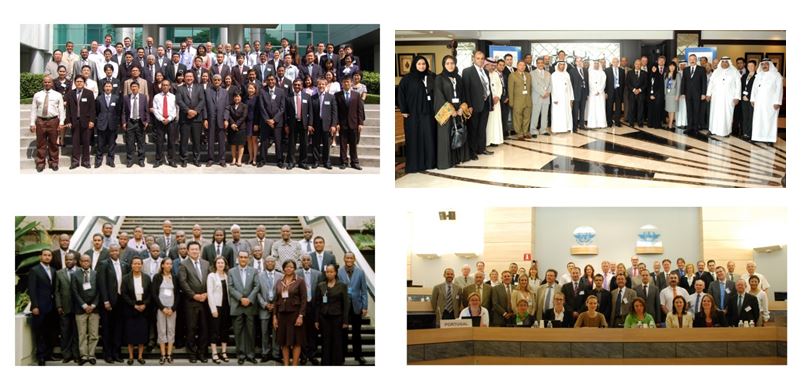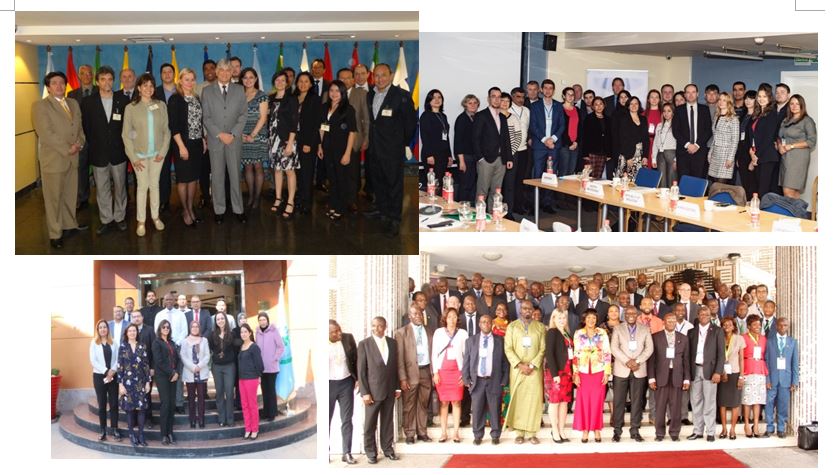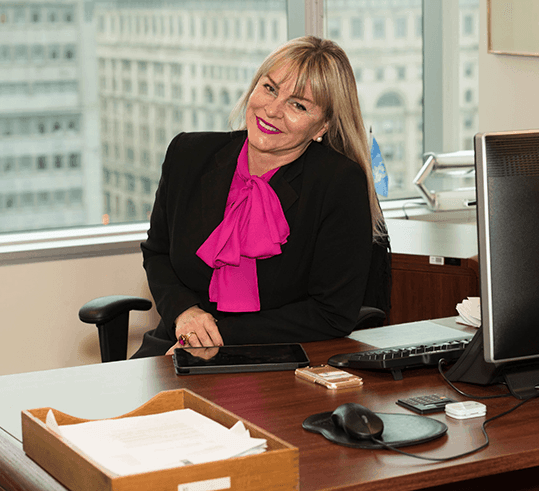Since the beginning of ICAO’s activities on environmental protection and in particular the development of policies and standards to limit and reduce the impact of aviation on the global climate, ICAO Member States clearly demonstrated their willingness in taking action on environmental protection. However, not all of them had the human, technical and financial resources to do so. To overcome this challenge and in the spirit of the “No Country Left Behind”, in 2010 ICAO launched the State Action Plan initiative on CO2 Emissions Reduction as a means to provide all States with the capacity and tools to take action.

This initiative enables all ICAO Member States to voluntarily establish a long-term strategy on climate change for the international aviation sector, involving all interested parties at the national level. These parties are encouraged to work together to define a quantified baseline emissions scenario, select appropriate emissions mitigation measures from ICAO’s basket of measures, and calculate the expected results of implementing those selected measures. The basket of measures includes aircraft technology advancement, operational improvements, sustainable aviation fuels, and market-based measures. States are invited to update their State Action Plans every three years, to enable ICAO to continually compile the quantified information submitted.
The level of details and quantified information submitted within a State Action Plan will ultimately facilitate ICAO’s assessment of the global progress towards meeting the two global aspirational goals for the international aviation sector: 2% annual fuel efficiency improvement through 2050; and carbon-neutral growth from 2020 onwards, as established at the 37th Session of the ICAO Assembly in 2010 and reaffirmed by subsequent Assembly sessions.

As at 8 October 2020, 119 States, representing 97.39% of global international aviation traffic in Revenue Tonne-Kilometres (RTK), had voluntarily submitted their State Action Plan to ICAO.
In order to support its 193 Member States with the development of their State Action Plans, ICAO has developed a series of guidance documents and quantification tools, such as the ICAO Carbon Emissions Calculator. Guidance on the development of States’ Action Plans on CO2 emissions reduction activities is contained in ICAO 9988. ICAO also developed a free online learning course, in cooperation with the United Nations Institute for Training and Research (UNITAR).
Additionally, in order to ensure that resources are available to States for the development of their action plan, following the Assembly in 2013, ICAO successfully engaged in two joint partnerships with international organizations: the Global Environment Facility (GEF) and the United Nations Development Programme (UNDP); and one with the European Union.
Established in 2015, the ICAO-UNDP-GEF partnership enabled Member States to secure funding for the development of specific technical assistance projects, in support of the reduction of aviation emissions. A series of tools were also developed, such as the Marginal Abatement Cost (MAC) curves (designed to support States and their stakeholders in prioritizing the most appropriate international aviation CO2 emissions mitigation measures, in light of their respective costs and CO2 emissions reductions). A knowledge sharing platform was also created and four guidance documents on sustainable aviation fuels; renewable energy; financing; and regulations, were elaborated to support States in the implementation of climate action within aviation. One of the main deliverables under the ICAO-UNDP-GEF project was the Solar-at-gate pilot project, a small-scale project implemented at Norman Manley International Airport in Jamaica. This project could be easily replicated and illustrate both the use of clean energy and the associated CO2 emissions reductions for international aviation operations.

In parallel, in 2013, ICAO and the European Union signed an agreement to implement an assistance project: Capacity Building on CO2 mitigation from International Aviation. The ICAO-EU project provided assistance to a selected group of 14 States in Africa and the Caribbean in support of their efforts on three objectives: develop and implement a State Action Plan; establish aviation environmental systems for emissions monitoring at the State level; and identify, evaluate and implement mitigation measures. Funding was provided by the European Union, while ICAO conducted the implementation of the assistance project. Building on the success of this project, ICAO and the EU decided to launch a phase 2, starting in 2021 and aiming to assist 10 additional States in Africa.

Furthermore, over the decade, ICAO has conducted a series of regional workshops and seminars on State Action Plans. The inaugural seminar was in Mexico in 2011, followed by additional seminars in 2014-2015 and 2017, and virtual seminars in 2020. Through these seminars, ICAO created a platform for interactive discussions and managed to provide hands-on training to the States. In addition, recognizing the important role that capacity building plays and with the aim of improving States’ knowledge of the development of Action Plans, ICAO ensured that some of the seminars included training that was precisely directed to State focal points. The ICAO Action Plan on Emissions Reduction (APER) website was also specifically developed to assist State focal points with the preparation and submission of their Action Plans to ICAO. These efforts by ICAO have led to the update of Action Plans every three years by some States, as recommended by the ICAO Assemblies.


It is important to highlight the crucial role that the ICAO’s Member State Action Plans for international aviation have been playing in complementing the climate actions by Parties under the Paris Agreement and its Nationally Determined Contributions (NDCs) under the UNFCCC. ICAO’s ongoing close cooperation with other international organizations also continues to be an enabler for the achievement of the 2030 Agenda for Sustainable Development and the Sustainable Development Goals (SDGs)
Launched in 2016, the ICAO State Action Plan Buddy Programme also facilitates the creation of “Buddy Partnerships” between supporting States (States in a position to provide assistance to develop a State Action Plan) and supported States (States which are yet to develop an Action Plan, wish to do so and would benefit from receiving further support). These partnerships also facilitate the development of wider international cooperation among ICAO Member States.
These State Actin Plans Capacity Building and Assistance projects are concrete examples of ICAO’s efforts to achieve the objectives of the No Country Left Behind initiative in the area of environmental protection.
What’s next?
The continued success of the ICAO State Action Plans initiative requires the substantial involvements and cooperation of both States and other stakeholders in providing and further refining the quantified and qualified input. This is a continual process to ensure that State Action Plans are updated and reflective of the States’ situation and future planning. The priority for the new and updated State Action Plan should be to have more robust and quantified data for CO2 emissions baseline scenario and expected results from taking CO2 reduction actions, using internationally recognized methods.
 “The new and updated State Action Plans should also include new and emerging mitigation measures available to States, based on latest and future environment-driven technology and innovations, such as renewable energy, new sustainable aviation fuels that are becoming a reality, and more low carbon energy sources.
“The new and updated State Action Plans should also include new and emerging mitigation measures available to States, based on latest and future environment-driven technology and innovations, such as renewable energy, new sustainable aviation fuels that are becoming a reality, and more low carbon energy sources.
The new State Action Plan will also become an instrument for States for building back better on aviation, at the heart of considerations for the recovery of aviation in each State by looking into the solutions that will better support the State to achieve sustainable and resilient aviation in short, medium, and longer-terms.”
~Jane Hupe, ICAO Deputy Director,
Environmental Protection
While the State Action Plans are the primary means for States to showcase their policies and actions regarding international aviation emissions reduction, it also provides an opportunity to showcase the expected benefits from their efforts to address domestic aviation emissions reduction as co-benefits. This holistic approach is encouraged as it facilitates synergies from mitigation measures that can bring emissions reductions both at the international and domestic levels and facilitate States’ reporting to ICAO as well as other fora.
In addition, State Action Plans consistent with the ICAO Doc 9988, can be used to facilitate access to green financing for aviation CO2 mitigation measures. Indeed, with information compiled by following the steps for the State Action Plan development process, States can prepare a project concept based on internationally agreed methodologies in particular for the assessment of the environmental benefits (more information in the ICAO Guidance Document Financing Aviation Emissions Reductions).
The new and updated State Action Plans should also include forward-looking mitigation measures available to States, based on latest and future environment-driven technology and innovations, such as renewable energy, new sustainable aviation fuels that are becoming a reality, and more low carbon energy sources.
The implementation of robust monitoring, reporting and verification (MRV) system under CORSIA, will help States to quantify the CO2 emissions from the operators registered in their States, further facilitating the full quantification of their CO2 emissions in their States Action Plans. As more States and their airlines volunteer to participate in CO2 offsetting requirements under the Carbon Offsetting and Reduction Scheme for International Aviation (CORSIA), such volunteer States can also showcase the CORSIA contributions, as part of their State Action Plans. The important role of State Action Plans should be enhanced, as ICAO moves to explore the feasibility of a long-term climate goal for the international aviation sector.
Furthermore, in light of ongoing circumstances and challenges from the COVID-19 pandemic, the new approach to the State Action Plan will also serve as an instrument for States to build back better on aviation. Environmentally sound approaches need to be at the heart of their considerations for the recovery of aviation in each State, with solutions that will better support them to achieve sustainable and resilient aviation in short, medium, and longer-terms. There is not a one fits all solution and all measures count.
In order to continue to advance the work, it is essential that regional training be organized to encourage States and other stakeholders to move this work plan forward. In this regard, on the occasion of its 10th anniversary, ICAO is organizing five Regional Webinars on State Action Plans, with the support of the seven ICAO Regional Offices, which will highlight ICAO’s efforts to assist States in developing and implementing the State Action Plan initiative. A calendar of the events for the Regional Webinars in celebration of the 10th anniversary of the States Action Plan will be shared soon on the ICAO website.
Finally, here are the messages from the Director of ICAO’s Air Transport Bureau and ICAO Regional Directors on the occasion of the 10th Anniversary of the ICAO State Action Plan initiative:
 |
“Over these past ten years, ICAO and its Member States have continued to improve and innovate, now is the time to push forward. It is the time to ensure that every State has a fully developed and quantified State Action Plan, so that they can fully assess their needs and opportunities and how they are achieving progress. At ICAO, we look forward to our collective effort towards establishing a greener future for aviation, as this ten-year anniversary is the time to put the “action” back in the State Action Plans.” ~ Mohamed Khalifa Rahma, Director, Air Transport Bureau |
 |
“As the Region that hosted the first ever ICAO Hands-on training workshop for State Action Plans in 2011, we are proud to be, from the onset, part of ICAO’s successful journey on the reduction of CO2 emissions from international aviation. Since the launch of the State Action Plan initiative we have taken advantage of the diversity of our Region and promoted the planning and development of State Action Plans by our Member States. Our Office pledges to continue to support the APAC States to attain the highest levels of environmental performance and ensure our target of 90% submission of Action Plans by 2022 is attained.” ~Arun Mishra, Regional Director, ICAO APAC Region |
 |
“When determining the opportunities to resolve the environment issues and addressing CO2 emissions from international aviation in particular, the ICAO State Action Plans (SAP) have proven to be among the best tool to capture State activities.
The SAP development process engages and involves numerous aviation stakeholders, notably States and ICAO. This process has ultimately enhanced awareness and environmental benefits in the ESAF Region. Even as we celebrate the 10th anniversary, the ESAF Region has an achievement rate of 45% and we are fervently confident that our target of 100% is achievable in the next few years.” ~Barry Kashambo, Regional Director, ICAO ESAF Region |
 |
“The State Action Plan initiative enables ICAO Member States to establish a long term strategy on climate change for the international aviation sector. Since its beginning, the States Focal Points, in working together with ICAO and with their stakeholders, have been able to develop robust and quantified action plans allowing ICAO to measure the progress of the aviation sector to reach the environment aspirational goals set by the ICAO Assembly.
As we are celebrating the 10th anniversary of the initiative this year, we, at ICAO, want to support our States as much as possible to update their action plan to be submitted to ICAO. The objective for the EUR/NAT Region is that all States that have already developed an Action Plan update it and send it to ICAO prior to June 2021. The Office is committed to support the EUR/NAT States to develop and update their SAPs.” ~Silvia Gehrer, Regional Director, ICAO EUR/NAT Region |
 |
“We attribute our Region’s continuous environmental improvements to the very close liaison we have with our 15 Member States. This is also coupled with our goal to achieve sustainable growth of international civil aviation.
The SAP decade has seen a number of measures being implemented by MID States to reduce their CO2 emissions from civil aviation- mostly operational improvements. The MID Region has an achievement rate of 53%. We are excited about the next steps and look forward to implementing the ICAO MID Capacity Building Programme that we have developed to support our States on environment related matters, to achieve, inter-alia, the target of having an up-to-date SAP submitted by all MID States.” ~Mohamed Smaoui, Acting Regional Director ICAO MID Office |
 |
“The collaboration between ICAO Headquarters, the Regional offices, and our Member States has enabled the NAM/CAR States to continue towards substantive actions in this critical endeavour and ensuring that the Member States receive support and assistance related to SAP development.
As we mark this 10-year anniversary, we look forward to the years to come where we will make additional efforts and positive impact to ensure that the most relevant mitigation actions are used to contribute to emissions reduction for the benefit of our States, our planet, and each one of us.” ~Melvin Cintron, Regional Director, ICAO NACC Region |
 |
“The current objective of the SAM Regional Office is to support our States and raise their consciousness on the importance of keeping their SAPs updated- tri-annually.
Over that last 10 years, we have seen an increased number of SAM States that have submitted their SAPs to ICAO. Currently, only two States are yet to submit, but have made important progress in their preparations. As the Region with the greenest airport- we can arguably say that the SAPs are one of the most successful initiatives in terms of capacity building and assistance led by the ICAO Secretariat” ~Fabio Rabbani, Regional Director, ICAO SAM Region |
 |
“Since 2010, ICAO Member States, with the support of ICAO, have started to develop and update State Action Plans outlining their strategies to address climate change for the international aviation sector.
Several initiatives are ongoing to advance ICAO’s efforts towards limiting and reducing the impact of aviation operations on global climate. The tremendous efforts made and the very critical role played by the State Action Plan Focal Points in their respective States, including the necessary coordination between ICAO and all other relevant aviation stakeholders cannot be overemphasized. The WACAF Office remains committed to further support its Member States and their Focal Points through capacity building activities in the months to come to ensure timely development, update and subsequent submission of their State Action Plans by June 2021.” Prosper Zo’o Minto’o, Regional Director, ICAO WACAF Region |
